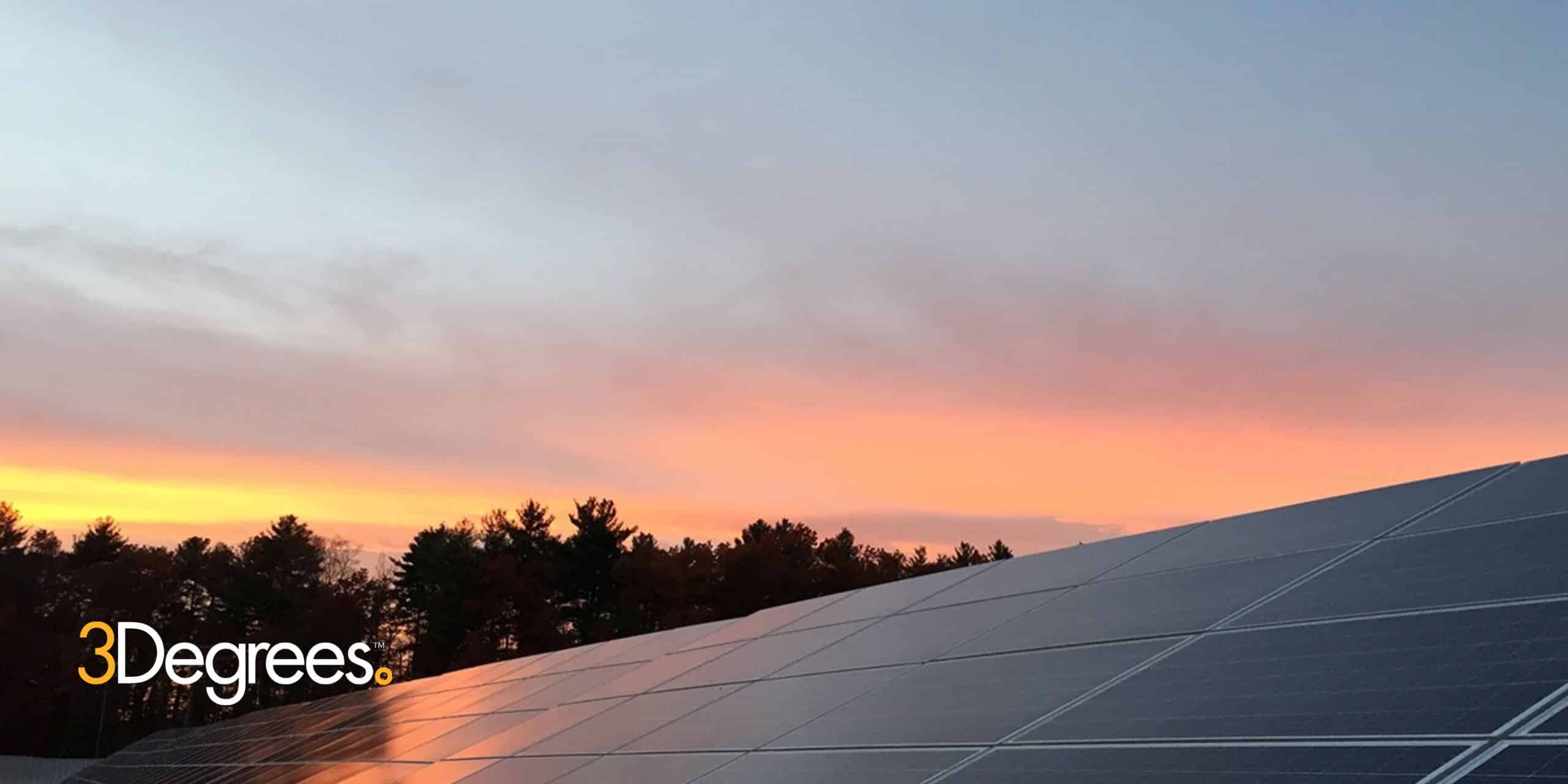Answers to your PPA and VPPA FAQs
Get answers to your frequently asked questions about power purchase agreements (PPAs) and virtual power purchase agreements (VPPAs).
Get our latest global market report
Get the renewable energy trends you need to stay ahead of the game in our Global Market Insights Report.

Get your questions about power purchase agreements (PPAs) and virtual power purchase agreements (VPPAs) answered here. Check back frequently for updates. Have a question that you need answered? Contact us.
Frequently Asked Questions:
Interested in more PPA insights?
Get 3Degrees’ Global Market Insights Report to keep track of market trends and their effects on the energy and PPA market landscape across the U.S., Europe and Asia-Pacific
Why are companies signing power purchase agreements (PPAs)?
Since 2014, corporate buyers have contracted significant amounts of renewable energy (more than 100 GW in North America and around 65 GW in Europe) in order to address their scope 2 emissions, support a decarbonized grid, take advantage of favorable market conditions, and capture the value of declining tax benefits. Most of these early movers used a well-proven structure (called a “contract for differences or CfD”) to enable them to gain economies of scale by signing large volumes from wind or solar projects in a financially optimal part of the country and then using those RECs to address their load elsewhere.
These long-term corporate contracts were directly responsible for enabling the financing of these renewable energy assets, thus also giving corporates the ability to prove their commitment to tackling climate change. Developers and energy providers are increasingly focused on building and managing renewable assets to meet growing demand. In recent years, there has been increasing interest in multi-technology PPAs, such as combining solar and wind projects, to further diversify and enhance reliability.
What is a power purchase agreement (PPA)? How does a physical PPA work?
A power purchase agreement (PPA) is a contract between two parties where one party (usually a renewable energy project developer) sells both electricity and energy attribute certificates (EACs) to another party (the energy buyer, sometimes called the offtaker).
EACs represent the environmental benefits of renewable energy generation. The environmental impact of EACs, or associated reductions, depends on whether the renewable project is additional or would have been built anyway.
PPAs are a good mechanism for companies to make a long-term commitment to purchasing renewable energy. Physical and virtual PPAs are the two most common forms of PPA contracts.
Traditionally, the most common type of PPA has been the physical PPA. This type of contract is used most often by utilities for their energy procurement, but experienced corporates also utilize this structure.
A physical PPA is structured as follows:
- The seller (e.g., the project developer) builds, owns, and operates the renewable energy project and sells the project’s generation and corresponding EACs as the revenue source to finance the construction of the project. PPAs are often used to finance construction of renewable energy projects by providing revenue certainty. The renewable energy project becomes a renewable asset that can attract investment.
- The buyer purchases the energy and EACs as they are generated by the project. The contract will specify a specified amount of energy to be purchased.
- The buyer takes legal title to the energy and the EACs at a delivery point agreed upon by the parties. The importance of the distribution network in connecting renewable projects to the grid cannot be overstated.
- After the buyer takes title to the energy, it is responsible for the management of the energy – moving and scheduling the energy to its load or selling it into the wholesale power market. This also requires forecasting of the project generation, the company’s load, and scheduling experience. Some companies elect to use a third-party service provider for scheduling.
Companies that have elected to pursue physical PPAs typically are highly experienced energy buyers and have large, geographically-consolidated electricity loads. They prefer to actively manage their energy supply and demand in parallel with meeting their renewable energy goals.
PPAs are typically signed for a long-term period, often ranging from 5 to 20 years. For companies, PPAs offer the benefit of price certainty, the ability to meet renewable energy goals, and the opportunity to hedge against future energy price increases. For sellers, PPAs provide long-term revenue certainty, which is critical for project financing and investment.
For more information on how PPAs and VPPAs work, see our article power purchase agreements.
What is a virtual power purchase agreement (VPPA)? How does a VPPA work?
A VPPA is a specific type of a PPA contract (collectively referred to as PPA contracts), used to procure long-term renewable energy. A VPPA is also known as a financial PPA or synthetic PPA, and unlike a physical PPA, it does not involve the transfer of physical energy but rather a financial settlement. The term virtual PPA is used because the buyer does not receive, nor take legal title to, the energy. A VPPA is a type of financial contract that provides financial stability for both parties. The buyer continues to receive physical power from its utility or retail provider, allowing the buyer to utilize a VPPA in a different region than where it uses electricity.
In a VPPA (which follows the mechanism of contract for differences or CfDs), a buyer pays a fixed price to the seller for the project’s generation and associated energy attribute certificates, or EACs. Instead of taking title to the power from the facility, the energy is liquidated into the wholesale power market by the seller. When the energy is sold into the wholesale power market, it receives the corresponding floating market price, and this revenue is passed through to the buyer.
More specifically, a VPPA is structured as follows:
- Similar to a physical PPA, the seller in a VPPA is typically a renewable energy project developer who builds, owns, and operates the project. The fixed PPA price received from the buyer under the VPPA serves as the revenue source for financing the project’s construction. The VPPA structure is often used to secure project funding for new renewable energy projects.
- The buyer agrees to pay the seller a fixed price for every MWh of renewable energy generated by the project. This fixed PPA price is the guaranteed price the developer will receive for its project. In a VPPA, this agreed fixed price is also known as the strike price.
- The project developer (or its agent) is responsible for selling the project output into the wholesale power market, receiving a market price on the agreed-upon delivery point.
- The CfD settlement is a comparison between the fixed price and the floating market price. When the market price exceeds the fixed VPPA price, the developer passes the positive difference to the buyer. When the converse is true – the market price is below the fixed VPPA price ‒ the buyer pays the developer the difference. VPPAs help manage market risks by stabilizing revenue streams.
- The buyer retains all of the EACs associated with the generated energy purchased under the VPPA.
For more information on how PPAs and VPPAs work, see our article Renewable Energy Power Purchase Agreements.
Learn how a European PPA portfolio enabled a food and beverage company achieve a decarbonization milestone
Introduction to renewable energy contracts
Renewable energy contracts are essential tools that enable organizations to support the transition to clean energy and achieve their sustainability goals. These agreements, which include power purchase agreements (PPAs), virtual power purchase agreements (VPPAs), and energy attribute certificates (EACs), create a structured pathway for companies to purchase renewable energy and demonstrate their commitment to reducing their carbon footprint.
In the context of the wholesale electricity market and broader energy markets, renewable energy contracts allow buyers to secure electricity generated from renewable sources—such as wind, solar, and other clean energy technologies—at a fixed price. This fixed price structure helps companies manage market price volatility and provides financial stability for both buyers and sellers. By locking in a predictable cost for renewable energy, organizations can better plan their energy budgets and hedge against fluctuations in energy market prices.
For EACs, different names are used around the world. In the U.S. and Canada, they are known as renewable energy certificates (RECs), while in Europe, the term guarantees of origin (GOs) is used. In all cases, certificates prove that a specific amount of electricity was generated from renewable sources. By purchasing EACs, companies can claim the environmental benefits associated with renewable energy, further supporting their renewable energy goals and contributing to a cleaner grid.
Overall, renewable energy contracts play a pivotal role in enabling companies to access clean energy, reduce their carbon emissions, and support the growth of renewable energy projects in the energy market.
Types of power purchase agreements (PPAs)
Power purchase agreements (PPAs) are versatile contracts that outline the terms under which energy buyers purchase renewable electricity from energy providers or project developers. There are several types of PPAs, each designed to meet different organizational needs and energy procurement strategies.
Physical PPAs involve the direct purchase of renewable electricity from a power generator, such as a wind farm or solar project. In this arrangement, the buyer takes physical delivery of the electricity produced by the generating assets, which may include wind turbines or solar panels. Physical PPAs are commonly used by large companies with significant, consolidated energy demand and the capability to manage the logistics of physical energy delivery.
Virtual PPAs (VPPAs) are financial contracts that allow companies to support renewable energy projects without taking physical delivery of the electricity. Instead, the buyer agrees to pay a fixed price for the power generated, while the electricity itself is sold into the wholesale market. The buyer and seller then settle the difference between the fixed PPA price and the market price. This structure enables companies to benefit from renewable energy generation and associated renewable energy certificates, regardless of their physical location.
PPAs can also be categorized based on the location and delivery of the renewable electricity:
- On-site PPAs involve installing renewable energy generating assets, such as solar panels, directly on the buyer’s premises. This allows the buyer to use the electricity produced on-site, reducing reliance on the grid and lowering energy costs.
- Baseload PPAs are structured to provide a consistent and predictable supply of renewable electricity, matching the buyer’s baseline energy needs. This helps ensure a stable energy supply and supports long-term energy planning.
By choosing the right type of PPA—whether physical, virtual, on-site, or baseload—organizations can tailor their renewable energy procurement to align with their operational requirements, sustainability goals, and financial strategies.

